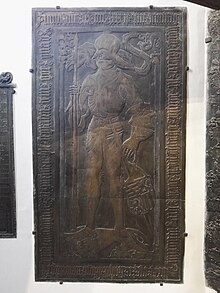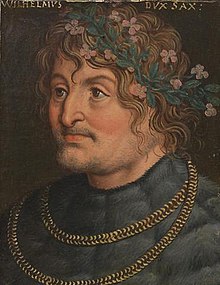William III. (Saxony)

William III. the brave (born April 30, 1425 in Meißen ; † September 17, 1482 in Weimar ) was a prince from the house of Wettin and carried the title of Duke of Saxony . He was the youngest son of Friedrich I , the Elector of Saxony , and Katharina von Braunschweig-Lüneburg .
Life
In contrast to his brother, Elector Fridrich II the Meek , Duke Wilhelm had unsteady personality traits. He did not agree with almost all of Friedrich's measures. Nevertheless, together with his brother, in March 1444 he decided on the great Saxon coin reform, in which for the first time an upper currency with high-quality Jewish head groschen and an auxiliary currency with depreciated shield groschen was introduced.
With the Altenburg division of the Wettin property in 1445 he received the Franconian and Thuringian part of the electorate ( Landgrave in Thuringia ), while his older brother Friedrich II "the meek" kept the Meissen part and above all the electoral dignity . However, disputes about the distribution led to the Saxon Fratricidal War in 1446, the day after Wilhelm's wedding , which only ended on January 27, 1451 with the Peace of Naumburg .
The minting of the coins of Electress Margaretha , the wife of his brother Friedrich II., In her own mint in Colditz in 1456 also led to the dispute , since Wilhelm did not have his share of the due treasure trove , as in the mints Freiberg and Leipzig . Duke Wilhelm successfully objected to the coinage of his sister-in-law (see Margarethengroschen ). The initially closed mint operation was soon resumed, however, the Electress was initially not allowed to appear as a mint princess. Only after the death of Elector Friedrich II on September 7, 1464, Wilhelm's attitude towards the Electress changed. From 1465 he minted again in community with his relatives in the mints of Freiberg, Gotha , Leipzig, Wittenberg and Zwickau and with the Electress Margaretha in Colditz. The completely new penny type " horn groschen " of the new Leipzig coin reform of April 4, 1465, coined with its relatives, was of great importance .
In 1439 Wilhelm was betrothed to Anna of Austria , the daughter of the German King Albrecht II . They married on June 20, 1446 in Jena “with great splendor and immense expense”. There were so many guests that "3860 horses alone had to be accommodated in Jena." Wilhelm wanted to enforce the inheritance claims to the Duchy of Luxembourg as well as Bohemia and Hungary acquired with this marriage . This brought him into conflict with Philip the Good of Burgundy , who forced him to withdraw after a few skirmishes. After the death of Anna's brother Ladislaus Postumus in 1457, Wilhelm carried the title "Duke of Luxembourg ". He had to give up his claims to Bohemia to King Georg von Podiebrad , his daughter Katharina was married to his son Heinrich von Münsterberg , his daughter Margarete von Sachsen to Johann Cicero von Brandenburg . Wilhelm's marriage to Anna had no male heirs; he imprisoned Anna at Eckartsburg , where she died in 1462. Afterwards he married his mistress Katharina von Brandenstein in 1463 . To strengthen this inappropriate marriage, he gave her family, among other things, the Ranis Castle .
In the Treaty of Eger in 1459 , Wilhelm, his brother Friedrich II and the Bohemian King Georg von Podiebrad established the border between Bohemia and Saxony at the level of the Ore Mountains and the middle of the Elbe , which is still largely valid today. It is one of the oldest still existing borders in Europe .
Wilhelm was the last Wettiner under whom the Landgraviate of Thuringia was an independent domain. Since he did not leave any sons, his possessions fell to his nephews Ernst and Albrecht . His Luxembourg inheritance fell to the Habsburgs . With the death of Wilhelm, the Gotha Mint had to cease operations. He had his Weimar mint closed as early as 1465 when he again had coins struck together with his relatives.
In Jerusalem in 1461 he received the knighthood of the Holy Sepulcher .
literature
- Frank-Lothar Kroll (Ed.): The rulers of Saxony. Margraves, electors, kings 1089–1918 . Beck, Munich 2004, ISBN 3-406-52206-8 .
- Thuringian State Gazette No. 11/2008 - ISSN 0939-9135 .
- Heinrich Theodor Flathe : Wilhelm III. (Margrave of Meissen and Duke of Saxony) . In: Allgemeine Deutsche Biographie (ADB). Volume 43, Duncker & Humblot, Leipzig 1898, pp. 124-127.
Individual evidence
- ↑ Gerhard Krug: The Meissnisch-Saxon Groschen 1338-1500 (1974), p. 88
- ↑ Walther Haupt: Sächsische Münzkunde (1974), p. 84
- ↑ Jonathan Carl Zenker : Historisch-topographisches Taschenbuch von Jena and its surroundings . Friedrich Frommann, Jena 1836, p. 6 .
- ↑ Wolfgang Steguweit : History of the Gotha Mint from the 12th to the 19th Century . Böhlau, Weimar 1987, ISBN 3-7400-0050-3 , p. 38.
- ↑ Johann Georg Kohl (ed.): Pilgrimage of Landgrave Wilhelm the Brave of Thuringia to the Holy Land in 1461 . C. Ed. Müller, Bremen 1868; ( Google Books ).
Web links
- Eberhard Holtz: Wilhelm III. (the brave) . In: Institute for Saxon History and Folklore (Ed.): Saxon Biography .
| predecessor | Office | successor |
|---|---|---|
| Friedrich V. |
Landgrave of Thuringia 1445–1482 |
serious |
| Maria |
Duke of Luxembourg 1457–1482 |
Maximilian I. |
| personal data | |
|---|---|
| SURNAME | William III. |
| ALTERNATIVE NAMES | William the Brave |
| BRIEF DESCRIPTION | Duke of Saxony, Prince of the House of Wettin |
| DATE OF BIRTH | April 30, 1425 |
| PLACE OF BIRTH | Meissen |
| DATE OF DEATH | September 17, 1482 |
| Place of death | Weimar |
